Hieroglyphic depiction
| ḥnw in hieroglyphs |
|---|
In Egyptian mythology, the hennu boat or Sokar barque (also henu, Manuel de Codage transliteration: Hnw) was a symbol of the god Seker of Memphis. Depending on the era or the prevailing dynasty of Egypt, the hennu boat sailed toward either dawn or dusk.
In the Pyramid Texts of Unas (PT 214, 138c) one of the steps the deceased had to take, after leaving his property to his son, after purifying himself, etc. was: You will descend on ropes of bronze, in the arms of Horus as his name is "Being in the Hennu barque."
On the holiday of the god Seker, a stone—possibly a representation of the god—was put on the Hennu barque and pulled with a sled over the fields, while people followed it wearing garlands of onions. A harpist's song from the tomb of Djehutimes (TT 32) describes the practice as follows: [He] pulled [So]kar by placing the Hennu barque on its sled, going around the walls with his following.
At times the Hennu barque was identified with Seker himself, as in pKairo CG 51189 (pYuya) where it is stated: I have appeared as Hennu. which is followed two lines below by this passage: I have appeared as Sokar.
| ḥnw in hieroglyphs |
|---|

Osiris is the god of fertility, agriculture, the afterlife, the dead, resurrection, life, and vegetation in ancient Egyptian religion. He was classically depicted as a green-skinned deity with a pharaoh's beard, partially mummy-wrapped at the legs, wearing a distinctive atef crown, and holding a symbolic crook and flail. He was one of the first to be associated with the mummy wrap. When his brother, Set, cut him up into pieces after killing him, Isis, his wife, found all the pieces and wrapped his body up, enabling him to return to life. Osiris was at times considered the eldest son of the god Geb and the sky goddess Nut, as well as being brother and husband of Isis, with Horus being considered his posthumously begotten son. He was also associated with the epithet Khenti-Amentiu, meaning "Foremost of the Westerners", a reference to his kingship in the land of the dead. Through syncretism with Iah, he is also a god of the Moon.

A solar deity is a sky deity who represents the Sun, or an aspect of it, usually by its perceived power and strength. Solar deities and Sun worship can be found throughout most of recorded history in various forms. The Sun is sometimes referred to by its Latin name Sol or by its Greek name Helios. The English word sun stems from Proto-Germanic *sunnǭ.

Horus or Her, Heru, Hor, Har in Ancient Egyptian, is one of the most significant ancient Egyptian deities who served many functions, most notably god of kingship and the sky. He was worshipped from at least the late prehistoric Egypt until the Ptolemaic Kingdom and Roman Egypt. Different forms of Horus are recorded in history and these are treated as distinct gods by Egyptologists. These various forms may possibly be different manifestations of the same multi-layered deity in which certain attributes or syncretic relationships are emphasized, not necessarily in opposition but complementary to one another, consistent with how the Ancient Egyptians viewed the multiple facets of reality. He was most often depicted as a falcon, most likely a lanner falcon or peregrine falcon, or as a man with a falcon head.
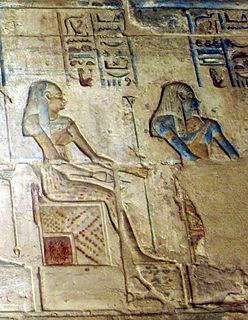
Nu, feminine Naunet, is the deification of the primordial watery abyss in the Hermopolitan Ogdoad cosmogony of ancient Egyptian religion. The name is paralleled with nen "inactivity" in a play of words in, "I raised them up from out of the watery mass [nu], out of inactivity [nen]". The name has also been compared to the Coptic noun "abyss; deep".
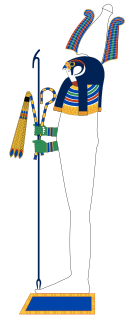
Seker is a falcon god of the Memphite necropolis.

A barque, barc, or bark is a type of sailing vessel with three or more masts having the fore- and mainmasts rigged square and only the mizzen rigged fore and aft. Sometimes, the mizzen is only partly fore-and-aft rigged, bearing a square-rigged sail above.
Shesmu is an ancient Egyptian deity with a contradictory character. He was worshiped from the early Old Kingdom period.

The Eye of Ra or Eye of Re is a being in ancient Egyptian mythology that functions as a feminine counterpart to the sun god Ra and a violent force that subdues his enemies. The Eye is an extension of Ra's power, equated with the disk of the sun, but it also behaves as an independent entity, which can be personified by a wide variety of Egyptian goddesses, including Hathor, Sekhmet, Bastet, Wadjet, and Mut. The Eye goddess acts as mother, sibling, consort, and daughter of the sun god. She is his partner in the creative cycle in which he begets the renewed form of himself that is born at dawn. The Eye's violent aspect defends Ra against the agents of disorder that threaten his rule. This dangerous aspect of the Eye goddess is often represented by a lioness or by the uraeus, or cobra, a symbol of protection and royal authority. The Eye of Ra is similar to the Eye of Horus, which belongs to a different god, Horus, but represents many of the same concepts. The disastrous effects when the Eye goddess rampages out of control and the efforts of the gods to return her to a benign state are a prominent motif in Egyptian mythology.

Jebel Barkal or Gebel Barkal is a very small mountain located some 400 km north of Khartoum, in Karima town in Northern State in Sudan, on a large bend of the Nile River, in the region called Nubia. The mountain is 98 m tall, has a flat top, and apparently was used as a landmark by the traders in the important route between central Africa, Arabia, and Egypt, as the point where it was easier to cross the great river. In 2003, the mountain, together with the historical city of Napata, were named World Heritage Sites by UNESCO. The Jebel Barkal area houses the Jebel Barkal Museum. The Jebel Barkal pyramids are one example of Nubian pyramids.

The four sons of Horus were a group of four gods in ancient Egyptian religion, who were essentially the personifications of the four canopic jars, which accompanied mummified bodies. Since the heart was thought to embody the soul, it was left inside the body. The brain was thought only to be the origin of mucus, so it was reduced to liquid, removed with metal hooks, and discarded. This left the stomach, liver, large intestines, and lungs, which were removed, embalmed and stored, each organ in its own jar. There were times when embalmers deviated from this scheme: during the 21st Dynasty they embalmed and wrapped the viscera and returned them to the body, while the canopic jars remained empty symbols.

In Egyptian mythology, Nemty was a god whose worship centered at Antaeopolis in the northern part of Upper Egypt.

The Opet Festival was an annual Ancient Egyptian Festival celebrated in Thebes (Luxor), especially in the New Kingdom and later periods, during the second month of the season of Akhet, the flooding of the Nile. The festival was celebrated to promote the Fertility of Amun-Re and the Pharaoh, who was also believed to be the spiritual offspring of Amun-Re; the Son/Daughter of Amun-Re. John Darnell argues that “Opet began on II Akhet 15 under Thutmose III and lasted 11 days ; by the beginning of the reign of Ramesses III, the festival stretched over 24 days”. The Festival included a ritual procession of the Barque of the cult statue of “Amun-Re, supreme god, his wife, Mut, and his son, Khons.”. This procession carried the statue for 2 km from Karnak Temple to “Luxor Temple, destination of the Opet Feast”. Once at the Luxor Temple, a ritual marriage ceremony between the Pharaoh and Amun-Re took place in the Birth room, spiritually linking them to ensure the Pharaoh’s fertility and reinstate the Pharaoh as the intermediary between the gods and Egypt. During the marriage ceremony, the Pharaoh was ceremoniously reborn through a re-crowning ceremony, emphasising the fertile nature of the Pharaoh and legitimising his divine right to rule. The ancient festival has been survived by the present-day feast of Sheikh Yūsuf al-Haggāg, an Islamic holy man whose boat is carried around Luxor in celebration of his life.
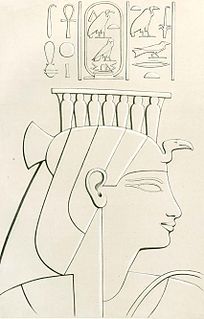
Mutemwiya was a minor wife of the Eighteenth Dynasty pharaoh Thutmose IV, and the mother of Pharaoh Amenhotep III. Mutemwiya's name means "Mut in the divine bark".
The Neshmet bark was a vessel belonging to the god Nun. The ancient Egyptian deity Osiris was transported in it on the river Nile during the Osiris festival at Abydos. The god's departure from his temple, journey to his tomb, and triumphant return were enacted and drew many spectators who participated in the public parts of the mysteries.

Atlanersa was a Kushite ruler of the Napatan kingdom of Nubia, reigning for about a decade in the mid-7th century BC. He was the successor of Tantamani, the last ruler of the 25th Dynasty of Egypt, and possibly a son of Taharqa or less likely of Tantamani, while his mother was a queen whose name is only partially preserved. Atlanersa's reign immediately followed the collapse of Nubian control over Egypt, which witnessed the Assyrian conquest of Egypt and then the beginning of the Late Period under Psamtik I. The same period also saw the progressive cultural integration of Egyptian beliefs by the Kushite civilization.
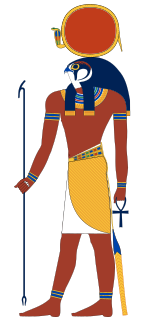
Ra or Re is the ancient Egyptian deity of the sun. By the Fifth Dynasty in the 25th and 24th centuries BC, he had become one of the most important gods in ancient Egyptian religion, identified primarily with the noon sun. Ra was believed to rule in all parts of the created world: the sky, the Earth, and the underworld. He was the god of the sun, order, kings, and the sky.

Neferkasokar was an Ancient Egyptian king (pharaoh) who may have ruled in Egypt during the 2nd Dynasty. Very little is known about him, since no contemporary records about him have been found. Rather his name has been found in later sources.
A coronation was an extremely important ritual in early and ancient Egyptian history, concerning the change of power and rulership between two succeeding pharaohs. The accession to the throne was celebrated in several ceremonies, rites and feasts.
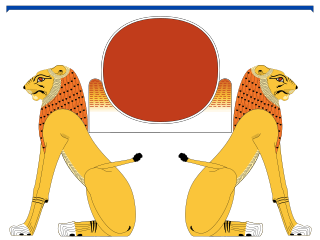
Aker was an ancient Egyptian earth and underworld god.
Khabawsokar was an Ancient Egyptian high official during the early to midst 3rd dynasty. He is famous for his tomb inscription and his unique nickname.
| This Ancient Egyptian religion article is a stub. You can help Wikipedia by expanding it. |